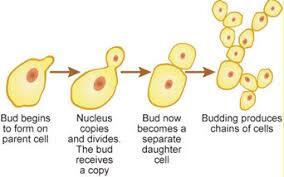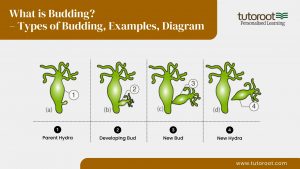What is Budding? Types of Budding, Examples, Diagram
Introduction
In the fascinating world of biology, reproduction is a fundamental process that ensures the continuation of species. Among the various modes of reproduction, budding stands out as a unique and intriguing method. This article delves into the concept of budding, exploring its types, and examples, and providing a comprehensive understanding of this biological phenomenon.
Explaining the Concept of Budding
Budding is a type of asexual reproduction where a new organism forms from a small growth or bud on the parent organism, resulting from cell division at a specific location. This process is distinct from sexual reproduction as it involves only one parent, and the offspring are genetically identical to the parent. Budding can be observed in various organisms, including yeasts, hydra, and certain plants. It plays a crucial role in their survival and propagation, especially in environments where conditions are stable and favourable for growth.
What is Budding?
Budding is a process where a new organism forms from a small projection called a bud, which emerges on the surface of the parent organism. The bud grows and develops, eventually detaching from the parent to become an independent organism. This method of reproduction is efficient and quick, allowing species to rapidly increase their population without the need for genetic recombination. Budding is not only limited to simple organisms; it can also be seen in certain higher plants and animals, showcasing the versatility and adaptability of this reproductive strategy.
Let’s Know the Examples of Budding
Budding can be observed in various organisms across different biological kingdoms. Some of the most well-known examples include:
- Yeast: In yeast, budding occurs as a small protuberance on the parent cell, which enlarges and eventually separates to form a new individual. This process is crucial for the rapid multiplication of yeast cells, especially in fermentation processes used in baking and brewing.
- Hydra: Hydra, a simple freshwater organism, reproduces through budding by developing a bud on its body. The bud grows, develops tentacles, and eventually detaches to become a new hydra. This method allows Hydra to quickly colonize new environments.
- Plants: In plants, budding can be observed in species like bryophyllum, where small buds develop along the leaf margins. These buds can fall off and grow into new plants, ensuring the spread and survival of the species.
Budding Diagram

Types of Budding
Budding can be categorized into several types based on the organisms in which it occurs. Let’s explore the different types of budding in more detail.
Budding in Yeast
Yeast, a unicellular fungus, reproduces asexually through a process called budding. In yeast, the process begins when a small bud forms on the parent cell. This bud enlarges as the parent cell replicates its genetic material. The nucleus divides, and one of the nuclei migrates into the bud. As the bud continues to grow, it eventually pinches off from the parent cell, forming a new yeast cell.
The budding process in yeast is highly efficient, allowing for rapid population growth. This characteristic is particularly beneficial in industries like baking and brewing, where yeast is essential for fermentation. The ability of yeast to reproduce quickly through budding ensures a steady supply of cells for these processes, making it a valuable organism in various biotechnological applications.
Budding in Hydra
Hydra, a simple multicellular organism found in freshwater environments, exhibits an interesting form of budding. In hydra, budding begins with the formation of a small bud on the body wall. This bud expands and forms tentacles and a mouth, gradually taking on the appearance of a small adult hydra. Once fully formed, the bud detaches from the parent organism and becomes an independent individual.
Hydra’s ability to reproduce through budding is advantageous in stable environments where conditions are favourable for growth. This mode of reproduction allows hydra to rapidly increase their population, ensuring the survival of the species. Additionally, the genetic uniformity of the offspring ensures that they are well-adapted to their environment, enhancing their chances of survival.
Budding in Plants
In the plant kingdom, budding can be observed in certain species, such as bryophyllum. Bryophyllum, also known as the “leaf of life,” exhibits a unique form of budding where small plantlets develop along the edges of its leaves. These plantlets, or buds, have their roots, stems, and leaves, allowing them to grow independently once they detach from the parent plant.
This method of reproduction is particularly advantageous for bryophyllum as it allows for the rapid spread and colonization of new areas. The plantlets can survive in various environmental conditions, ensuring the species’ survival and propagation. Budding in plants is not only limited to bryophyllum; other species also exhibit similar forms of asexual reproduction, highlighting the versatility of this reproductive strategy in the plant kingdom.
Final Notes
Budding is a fascinating and efficient mode of asexual reproduction that ensures the rapid propagation and survival of species. Whether in yeast, hydra, or plants, budding allows organisms to quickly and effectively increase their population without the need for genetic recombination. This method of reproduction is particularly advantageous in stable environments where conditions are favourable for growth, ensuring the survival and propagation of species across various biological kingdoms.
If you’re looking for clear and simple explanations of various concepts like the ones we’ve discussed, visit the Tutoroot Blog section. For an even deeper understanding and personalised assistance in biology, consider Tutoroot’s Biology online coaching classes. Start your journey to mastering subjects with Tutoroot’s online tuition. Arrange a FREE DEMO session today!
FAQs
What is Budding Reproduction?
Budding reproduction is a form of asexual reproduction where a new organism develops from an outgrowth or bud on the parent organism. The bud grows, develops, and eventually detaches to become an independent organism, genetically identical to the parent.
Give a Few Budding Examples
Examples of budding include yeast, where small buds form on the parent cell; hydra, where buds develop on the body and detach as new individuals; and bryophyllum, where plantlets form along the leaf margins.
Is Rose an Example of Budding?
No, roses do not reproduce through budding. Roses typically reproduce through sexual reproduction involving flowers, seeds, or vegetative propagation methods like cuttings and grafting. Budding, as described in this article, refers to asexual reproduction observed in organisms like yeast, hydra, and certain plants.

